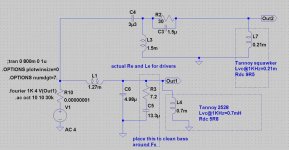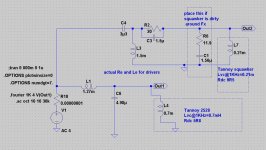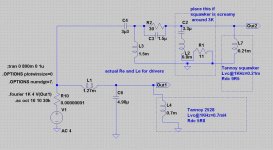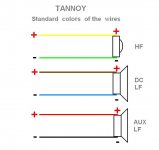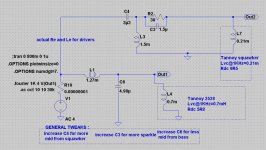If some kind of HF adjustment is needed at all, autoformer is probably better solution than L-pad or resistor voltage divider. Tannoy used it in some cheap studio monitors (Reveal) insted of voltage divider without adjustment possibility, just single secondary tap. The BIG problem with autoformer with adjustment was switch contacts. But very simple measure was needed to keep it clean: switch it back and forth once each day and they will work just fine forever! Also switch it while playing at some substantial spl and the arcing will clean it. (These solutions are necessary as it is very difficult to open switch for cleaning)
I personally enjoy to use the switches, it is very nice to apply some settings to different recorded material!
Thanks for the switch hints!
for short time I had pair of Dorset(s) , I took opportunity to dismantle everything , and that included thorough disassemble of switches , cleaning and greasing them with some tech. vaseline
routine thing , considering myriad of VCRs and amps I repaired .....
routine thing , considering myriad of VCRs and amps I repaired .....

for short time I had pair of Dorset(s) , I took opportunity to dismantle everything , and that included thorough disassemble of switches , cleaning and greasing them with some tech. vaseline
routine thing , considering myriad of VCRs and amps I repaired .....
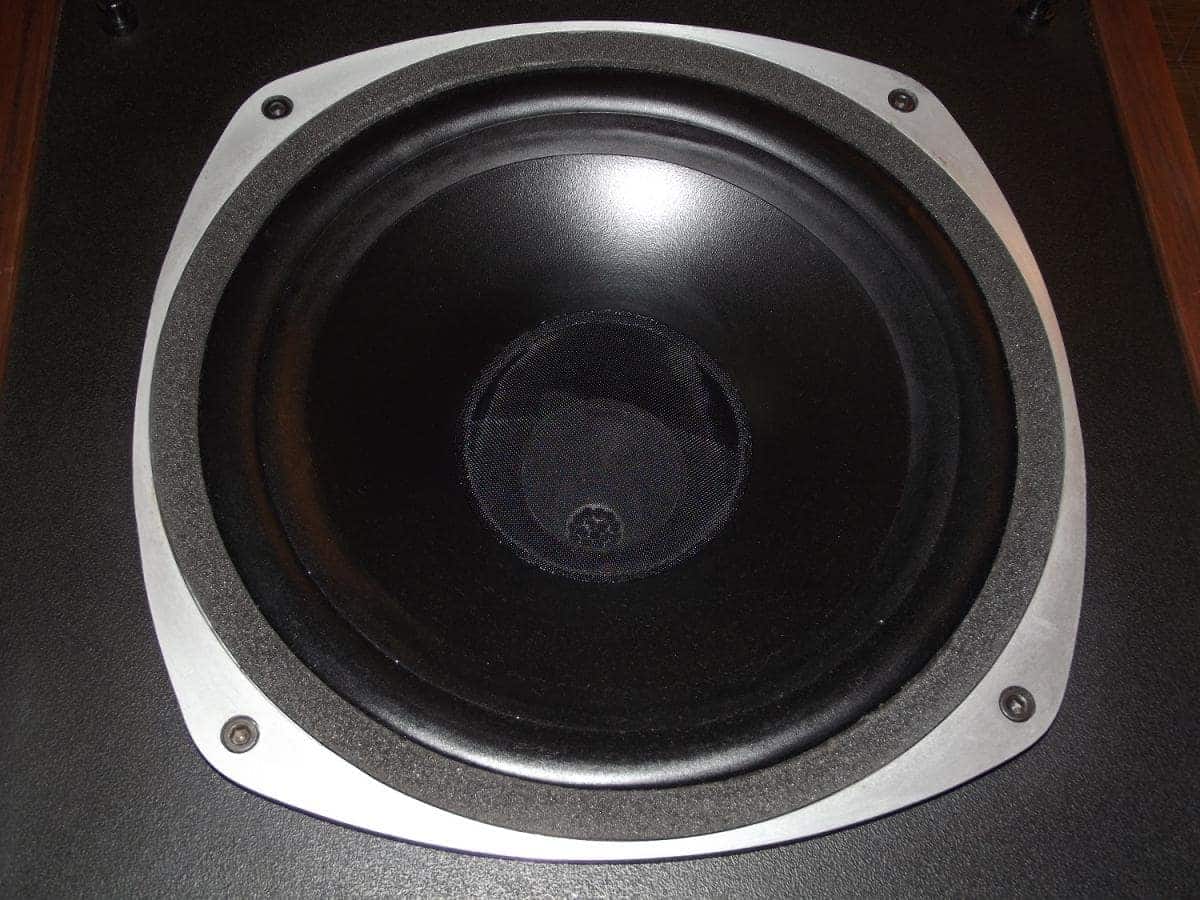
😎
These are mine........😱
😀😀
The interesting question is why shows the original in our Spice simulation a crossover point at nearly 4kHz. And nearly all brochures speak of 1k5 Hz.
I found only one source speaking of 3k5 Hz.
Mikorist and ZM, please what was the crossover point with the Dorset in Spice?
Is it possible they changed during production time this feature?
Or do we miss a point?
😀😀
The interesting question is why shows the original in our Spice simulation a crossover point at nearly 4kHz. And nearly all brochures speak of 1k5 Hz.
I found only one source speaking of 3k5 Hz.
Mikorist and ZM, please what was the crossover point with the Dorset in Spice?
Is it possible they changed during production time this feature?
Or do we miss a point?
give me some time - tomorrow I'll post some info I have about Dorsets , on my blog
maybe I'll have time to make some sim , even if I'm not finding that so necessary
maybe I'll have time to make some sim , even if I'm not finding that so necessary
The electrical filter and the acoustical filter are not always the same.
The waveguide/horn loading of the tweeter of the cone has it's own natural roll off and bump in amplitude from the loading. A 6dB electrical filter up higher combined with what the driver is doing would get you a steeper acoustical filter lower down in frequency.
I don't think you are taking that into account in your models.
To model it better you would need the FR and impedance of the driver.
The waveguide/horn loading of the tweeter of the cone has it's own natural roll off and bump in amplitude from the loading. A 6dB electrical filter up higher combined with what the driver is doing would get you a steeper acoustical filter lower down in frequency.
I don't think you are taking that into account in your models.
To model it better you would need the FR and impedance of the driver.
for short time I had pair of Dorset(s) , I took opportunity to dismantle everything , and that included thorough disassemble of switches , cleaning and greasing them with some tech. vaseline
routine thing , considering myriad of VCRs and amps I repaired .....
Zen Mod,
That's real diy spirit!
If the crossover adjustment switches are left unused for months, or worse for years, sound from compresssion horn driver just becoms horrible, dirty sounding and muddy. Many wrong conclusions were drawn about the sound of vintage Tannoy loudspeakers based on the fact that the switches were left unused for long time, while in fact all that was necessary to restore the missing clarity was to move switches back and forth 30-40 times for self cleaning.
The electrical filter and the acoustical filter are not always the same.
The waveguide/horn loading of the tweeter of the cone has it's own natural roll off and bump in amplitude from the loading. A 6dB electrical filter up higher combined with what the driver is doing would get you a steeper acoustical filter lower down in frequency.
I don't think you are taking that into account in your models.
To model it better you would need the FR and impedance of the driver.
you're right , of course
modeling , in this case , is with goal of simple comparison between few iterations , being well aware of demands which pepperpot is presenting to filter meaning mainly on 3K dip and normal Newman behavior
so , inevitably , if one needs Tann to behave in most achievable linear manner , that always result in more or less classic Tann xover
in this case , Mayfair is having anything but classic DC xover , and that can't be of much good
Anyone try one of the "quasi-optimal" crossovers for high efficiency speakers with the Tannoys yet?
http://www.diyaudio.com/forums/mult...sover-high-efficiency-loudspeaker-system.html
Something I have been thinking about when I finally get my Tannoys home in a couple of weeks.
http://www.diyaudio.com/forums/mult...sover-high-efficiency-loudspeaker-system.html
Something I have been thinking about when I finally get my Tannoys home in a couple of weeks.
Generg , I didn't posted Dorset info on blog , but prepared this ;
will do that later , maybe even tonight
If you have mike on disposal , it can be handy now ......
for starters , you can use even crapiest quality inductors ; when you finish testing and declare final values , then you can make proper ones , or buy them
I forgot to write on schmtcs - if Hf driver is too hot , generally - place 47R (or lower ) across L3
will do that later , maybe even tonight
If you have mike on disposal , it can be handy now ......
for starters , you can use even crapiest quality inductors ; when you finish testing and declare final values , then you can make proper ones , or buy them
I forgot to write on schmtcs - if Hf driver is too hot , generally - place 47R (or lower ) across L3
Attachments
Last edited:
Oh my god ZM..... 🙂
Real program! I need some time for components etc.
What is dirty and what is screamy?
Thank you so much!
Real program! I need some time for components etc.
What is dirty and what is screamy?
Thank you so much!
btw.
Happy B. to G.

dirty - not clear
screamy - ears are falling off
I repeat - for components - use cheapest you can find , for start
generally - try to finish with smallest number of parts/cells in xover
what's essential is in Step 1
edit - enclosed Farbe Nomenclatur ; taken from some Russian Forum
it can be handy for starters , to mark pos. terminals on drivers (check that too , with 1V5 battery)
Happy B. to G.

dirty - not clear
screamy - ears are falling off

I repeat - for components - use cheapest you can find , for start
generally - try to finish with smallest number of parts/cells in xover
what's essential is in Step 1
edit - enclosed Farbe Nomenclatur ; taken from some Russian Forum
it can be handy for starters , to mark pos. terminals on drivers (check that too , with 1V5 battery)
Attachments
Last edited:
G.
I simply forgot that I already blogged what I have on Dorset
will include Rdc and Lc info you measured .....
Tannoy Dorset vivisection | Zen Mod Blog

I simply forgot that I already blogged what I have on Dorset
will include Rdc and Lc info you measured .....
Tannoy Dorset vivisection | Zen Mod Blog

G.
I simply forgot that I already blogged what I have on Dorset
will include Rdc and Lc info you measured .....
Tannoy Dorset vivisection | Zen Mod Blog

MAX position is high - end .. I would not touch the original 😀
- Status
- Not open for further replies.
- Home
- Loudspeakers
- Multi-Way
- The Tannoy Story by Julian Alderton ??!

